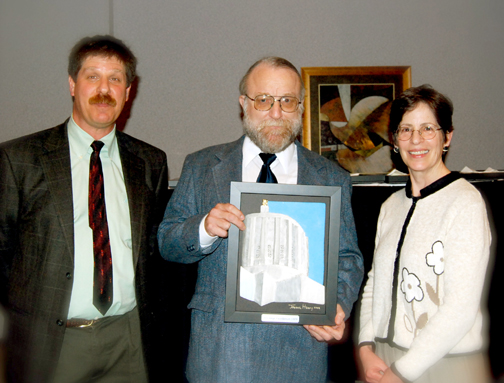2009 Oregon Heritage Excellence Award
Owl Ridge Trails Project
Dr. Bob Zybach (center) is shown receiving a 2009 Heritage Excellence Award on behalf of Oregon Websites and Watersheds Project, Inc., and the Confederated Tribes of Grand Ronde in Portland, Oregon on April 17, 2009. The award was presented by Mary Oberst (right), Oregon's First Lady and wife of Governor Ted Kulongoski, and by George Kramer (left), Chair of the Oregon Heritage Commission, for work completed on the Owl Ridge Trails Project.
The Owl Ridge Trails Project received a 2009 Oregon Heritage Excellence Award.given by the Oregon Heritage Commission (OHC) at a special awards ceremony in Portland, Oregon on April 17, 2009. The award was accepted by Dr. Bob Zybach on behalf of Oregon Websites and Watersheds Project, Inc. (ORWW), and the Confederated Tribes of Grand Ronde (CTGR). The award was presented by George Kramer, Chair of the OHC, and Oregon First Lady, Mary Oberst. A formal presentation speech was read to the gathering of about 150 historians and cultural resource specialists while project maps and photographs were shown on a wall-sized screen behind the podium.
The Owl Ridge Trails Project was formally nominated for the award by Michael Dubrasich, Executive Director of the Western Institute for Study of the Environment (W.I.S.E.), who featured the project on their educational website:
http://westinstenv.org/sosf/2008/08/21/the-gordon-meadows-project/
In his acceptance speech, Dr.
Zybach made particular mention of Tribal elders Pat Allen and Bob Tom, David
Lewis, John Mercier, the Tribal Council, and Volker Mell of the CTGR, and
Wayne Giesy, Jeanne Gay,
and Stuart Hemphill
from
ORWW. The 2009 award was presented to eight different projects and individuals
in all, and included a framed original ceramic of the State Capitol Building.
The awards were created by Jeanne Henry Ceramic Art by.firing multiple levels
of clay layered and carved, textured, and beveled over a sketch of a photograph.
The three-dimensional results were then dried, stained, painted, waxed,
glazed and individually fired at 2250-degrees F.
Gordon Meadows Prairie Restoration Plan
Smoke Signals Newspaper Article (PDF -- text only)
Oregon Heritage Commission presentation statement (read by George Kramer)
Owl Ridge is a Key feature of an ancient 250,000-acre camas prairie, berry patch, beargrass meadow, hunting ground, wetland, fishing hole and ridgeline trail complex near the headwaters of the Santiam River and Blue River in the central Oregon Cascade Mountains.
More than a half dozen tribal groups used these lands, including travelers, hunters, traders, basketweavers, cooks and food gatherers.
In 2006, a project started to learn more about the geography, ecology and lifeways of the Molallan families who lived and worked in this area from about 1750-1850. Researchers located and documented relict evidence of plants and trails used by these people.
The collaborative researchers documented native trails, berry fields, camas meadows, and other lands used at nearly 500 GPS points and with more than 1,500 photographs.
The work has resulted in a series of products useful for cultural resource management and education. These include several new GPS mapping layers over this area, three educational websites containing historical photographs, and a plan for restoration of a key location in the Owl Ridge area.
The Owl Ridge Trails Project will enable the restoration and maintenance of cultural landscape patterns in the area. This includes recreation of traditional Molallan hunting, gathering and resource management practices. This implementation plan will enable stewardship of traditional culture uses and inspire Indian and non-Indian alike.
We present this Oregon Heritage Excellence Award to the Owl Ridge Trails Project for its multi-disciplinary effort increasing knowledge and understanding of the prehistory and history of the South Santiam and Blue River headwaters.
©2009 Oregon Websites & Watersheds Project, Inc.
